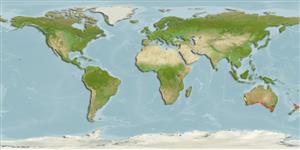ກຸ່ມປາກະດູກອ່ອນ (ເຊັ່ນ: ປາສະຫລາມ, ປາຜາໄລ) (sharks and rays) >
Myliobatiformes (Stingrays) >
Myliobatidae (Eagle and manta rays)
Etymology: Myliobatis: Greek, mylo = mill + Greek, + Greek, batis,-idos = a ray (Raja sp.) (Ref. 45335).
More on author: Macleay.
Environment: milieu / climate zone / depth range / distribution range
ນິເວດວິທະຍາ
ສັດທະເລ ກ່ຽວກັນຫີນ; ລະດັບຄວາມເລິກ 1 - 85 m (Ref. 9862). Subtropical; 27°S - 43°S
Eastern Indian Ocean: southern Australia, from Western Australia to Queensland. Possibly occurring off New Zealand.
ຂະໜາດ / ນ້ຳໜັກ / Age
Maturity: Lm ? range ? - ? cm
Max length : 120 cm WD ຕົວຜູ້/ບໍ່ມີເພດ; (Ref. 6871); ນ້ຳໜັກສູງສຸດທີ່ເຄຍຈັດພີມມາ: 56.5 kg (Ref. 40637)
Commonly found off beaches and over sand flats in shallow water. Also found offshore down to 85 m (Ref. 9862). Feeds mainly on crabs and shellfish (Ref. 6871). Ovoviviparous (Ref. 50449).
Life cycle and mating behavior
Maturities | ການສືບພັນ | Spawnings | Egg(s) | Fecundities | ຕົວອ່ອນ
Exhibit ovoviparity (aplacental viviparity), with embryos feeding initially on yolk, then receiving additional nourishment from the mother by indirect absorption of uterine fluid enriched with mucus, fat or protein through specialised structures (Ref. 50449).
Last, P.R. and J.D. Stevens, 1994. Sharks and rays of Australia. CSIRO, Australia. 513 p. (Ref. 6871)
IUCN Red List Status (Ref. 130435)
Threat to humans
Venomous
Human uses
ຊະນິດປາທີ່ຖືກນຳໃຊ້ເຂົ້າໃນການຫາເພື່ອເປັນເກມກິລາ: ແມ່ນ
ເຄື່ອງມື
Special reports
Download XML
ແຫຼ່ງອີນເຕີເນັດ
Estimates based on models
Preferred temperature (Ref.
123201): 15 - 20.1, mean 17.4 °C (based on 236 cells).
Phylogenetic diversity index (Ref.
82804): PD
50 = 0.5002 [Uniqueness, from 0.5 = low to 2.0 = high].
Bayesian length-weight: a=0.00389 (0.00123 - 0.01235), b=3.08 (2.82 - 3.34), in cm total length, based on LWR estimates for this (Sub)family-body shape (Ref.
93245).
ຊັ້ນເຂດຮ້ອນ (Ref.
69278): 3.6 ±0.55 se; based on food items.
ຄວາມຢືດຢຸ່ນ (Ref.
120179): ຕຳ່, ປະຊາກອນຕຳ່ສຸດທີ່ໃຊ້ເວລາສອງເທົ່າ 4.5 - 14 ປີ (Fec assumed to be <100).
Fishing Vulnerability (Ref.
59153): Very high vulnerability (83 of 100).
Nutrients (Ref.
124155): Calcium = 4.25 [0.47, 67.92] mg/100g; Iron = 0.393 [0.033, 4.254] mg/100g; Protein = 21.5 [16.2, 26.7] %; Omega3 = 0.113 [0.037, 0.324] g/100g; Selenium = 15.7 [2.8, 83.7] μg/100g; VitaminA = 14.1 [1.2, 162.4] μg/100g; Zinc = 0.464 [0.031, 5.171] mg/100g (wet weight);
